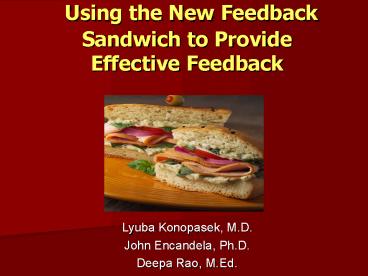Using the New Feedback Sandwich to Provide Effective Feedback - PowerPoint PPT Presentation
1 / 26
Title:
Using the New Feedback Sandwich to Provide Effective Feedback
Description:
Describe rationale for and barriers to giving feedback. Distinguish feedback from reinforcement and evaluation of medical students ... – PowerPoint PPT presentation
Number of Views:1189
Avg rating:5.0/5.0
Title: Using the New Feedback Sandwich to Provide Effective Feedback
1
Using the New Feedback Sandwich to Provide
Effective Feedback
- Lyuba Konopasek, M.D.
- John Encandela, Ph.D.
- Deepa Rao, M.Ed.
2
Learning Objectives
- Describe rationale for and barriers to giving
feedback - Distinguish feedback from reinforcement and
evaluation of medical students - Describe types of feedback in medical education
- Describe essential elements of giving effective
feedback - Observe and practice giving feedback
3
RATIONALE
4
Rationale for Giving Feedback in Medical Education
- Without feedback, mistakes go uncorrected,
good performance is not reinforced, and clinical
competence is achieved empirically or, not at
all.
Ende J. Feedback in Clinical Medical Education.
JAMA 1983250777-781.
5
DEFINITIONS
6
- I am thinking of a number between 1 and 100.
7
How Do They Differ?
- Minimal Feedback/Reinforcement
- Evaluation
- Feedback
8
Reinforcement/Minimal Feedback
- Statement expressing positive (or negative)
reaction to a behavior which aims to increase (or
decrease) the likelihood of that behavior
happening again - That was a great presentation
- You need to work on your presentation skills
- Often mistaken for feedback
- Timing is similar - immediate
9
Evaluation
- Qualitative judgment which ranks a learners
performance in comparison to other learners - 3.7 for professionalism competence
- Often the only measure of performance visible to
the learner - Usually given after the performance is over
10
Feedback
- (Reinforcement or correction) Explanation
- Keeps you on course to meet goals
- Allows you to adjust your course to meet goals
- Given immediately after the performance or at
some time soon after, when the learner still has
time to demonstrate improvement
11
TYPES OF FEEDBACK
12
Types of Feedback in Medical Education
- Brief feedback - 2-5 minutes
- On a clinical skill
- Major feedback - 10-30 minutes
- Scheduled mid-point through a learning experience
- Remedial feedback
Branch J, Paranjape A. Feedback and Reflection
Teaching Methods for Clinical Settings. Academic
Medicine. 2002771185-1188.
13
ESSENTIAL COMPONENTS
14
The Old Feedback Sandwich
Praise Criticism Praise Is it more
palatable?
15
The New Feedback Sandwich
Ask Tell Ask
Adaptation of The New Feedback Sandwich, common
in patient-physician communication literature
adapted by Lyuba Konopasek, MD, for use in
medical resident feedback settings.
16
Ask
- Ask learner to assess own performance first
- What went well and what could have gone better?
- What were their goals?
- Have they ever seen a patient like this before?
- Begins a conversation
- Assesses learners level of insight
- Promotes reflective practice
17
In Asking Learner to Self-Reflect
- Resist getting to the quick of the matter
give learner time to reflect on behavior
18
Tell
- Tell what you observed diagnosis and explanation
about specific observed behaviors - React to the learners observation
- Feedback on self-assessment
- Include both positive and corrective elements
- I observed.
- Give reasons in the context of well-defined
shared goals
19
Ask (again)
- Ask about recipients understanding and strategies
for improvement - What could you do differently?
- Again, give ample time
- Give own suggestions
- Perhaps even replay parts of the encounter show
me - Commit to monitoring improvement together
20
Limit the Quantity
21
BEFORE Giving Feedback Prepare Effectively
- Plan what you will say
- Play out the conversation in your head
- Make sure that you have enough information
- Is it gestalt, or specific
- Think about who else you need to collect
information from - If feedback is second hand, do you have enough
specific, behaviorally based information? - Was it documented by the other person?
22
AFTER Giving Feedback Reflect on How it Went
- What was effective?
- What could be done differently?
- Were you well prepared?
- Future strategies
- Do you need to document?
- Do you need help?
23
See one, then do one
24
Checklist The Feedback Dialogue
- Ask learner to assess own performance first
- What went well and what could have gone better?
- Tell what you observeddiagnosis and explanation
- React to the learners observation
- Include both positive and constructive elements
- Give reasons in the context of well-defined
shared goals - Regulate quantity
- Ask about recipients understanding and strategies
for improvement - What could you do differently?
- Give own suggestions
- Perhaps even replay parts of the encounter - show
me - Commit to monitoring improvement together
Adaptation of The New Feedback Sandwich, common
in patient-physician communication literature
adapted by Lyuba Konopasek, MD, for use in
medical resident feedback settings.
25
.AND FINALLY
26
End with Ende
- The important things to remember about
feedback in medical education are that (1) it is
necessary, (2) it is valuable, and (3) after a
bit of practice and planning, it is not as
difficult as one might think. - Jack Ende,
MD
Ende J. Feedback in Clinical Medical Education.
JAMA 1983250777-781.































